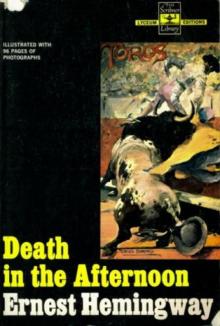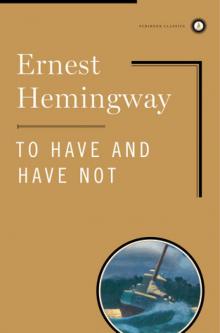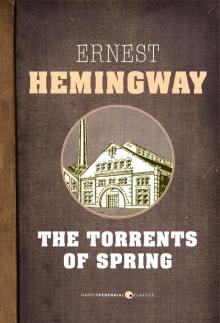- Home
- Ernest Hemingway
By-Line Ernest Hemingway Page 3
By-Line Ernest Hemingway Read online
Page 3
Most of the blood money from Ireland went to back some pony or other. For the gunman believes in taking a chance. He believes that if he can make enough of a stake he can settle down and quit the business. But it is hard for him to quit, for there are very few professions outside of prize-fighting that pay so well.
The retired shuffler off of mortal coils who honors me with his acquaintance is about thirty-eight. Perhaps it were better not to describe him too closely, because he might run on to a Toronto paper. But he is about as handsome as a ferret, has fine hands, and looks like a jockey a little overweight.
He quit gunning when the quitting was good—when the country went dry and liquor running became the best paying outdoor occupation.
After his principal customers discovered that it was altogether better and cheaper to ship whiskey up from the big warehouses in Kentucky than to take the chance of running it across the imaginary line that separates the U.S. and Canada he retired.
Now he is a man about town and bond salesmen call on him. When I talked with him he kept steering the subject away from gunning and the Irish situation to ask my honest opinion on some Japanese government bonds that will pay eleven per cent interest.
In the course of an afternoon I learned a number of things about the trade. Yes, there were American “bump-off” artists in Ireland. Yes, he knew some that were there personally. Well, he didn’t know who was in the right in Ireland. No, it didn’t matter to him. He understood it was all managed out of New York. Then you worked out of Liverpool. No, he wouldn’t care particularly about killing Englishmen. But, then, they gotta die sometime.
He’s heard that most of the guns were Wops—Dagoes, that is. Most gunmen were Wops, anyway. A Wop made a good gun. They usually worked in pairs. In the U.S.A. they nearly always worked out of a motor car, because that made the getaway much easier. That was the big thing about doing a job. The getaways. Anybody can do a job. It’s the getaway that counts. A car made it much easier. But there was always the chauffeur.
Had I noticed, he went on, that most of the jobs that fell through were the fault of the chauffeur? The police traced the car and then got the chauffeur and he squealed. That was what was bad about a car, he said. “You can’t trust any of them.”
That’s the type of mercenary that is doing the Irishmen’s killings for them. He isn’t a heroic or even a dramatic figure. He just sits hunched over his whiskey glass, worries about how to invest his money, lets his weasel mind run on and wishes the boys luck. The boys seem to be having it.
Tuna Fishing in Spain
The Toronto Star Weekly • FEBRUARY 18, 1922
VIGO, SPAIN.—Vigo is a pasteboard looking village, cobble streeted, white and orange plastered, set up on one side of a big, almost landlocked harbor that is large enough to hold the entire British navy. Sun-baked brown mountains slump down to the sea like tired old dinosaurs, and the color of the water is as blue as a chromo of the bay at Naples.
A grey pasteboard church with twin towers and a flat, sullen fort that tops the hill where the town is set up look out on the blue bay, where the good fishermen will go when snow drifts along the northern streams and trout lie nose to nose in deep pools under a scum of ice. For the bright, blue chromo of a bay is alive with fish.
It holds schools of strange, flat, rainbow-colored fish, hunting-packs of long, narrow Spanish mackerel, and big, heavy-shouldered sea-bass with odd, soft-sounding names. But principally it holds the king of all fish, the ruler of the Valhalla of fishermen.
The fisherman goes out on the bay in a brown lateen sailed boat that lists drunkenly and determinedly and sails with a skimming pull. He baits with a silvery sort of a mullet and lets his line out to troll. As the boat moves along, close hauled to keep the bait under water, there is a silver splatter in the sea as though a bushel full of buckshot had been tossed in. It is a school of sardines jumping out of water, forced out by the swell of a big tuna who breaks water with a boiling crash and shoots his entire length six feet into the air. It is then that the fisherman’s heart lodges against his palate, to sink to his heels when the tuna falls back into the water with the noise of a horse diving off a dock.
A big tuna is silver and slate blue, and when he shoots up into the air from close beside the boat it is like a blinding flash of quicksilver. He may weigh 300 pounds and he jumps with the eagerness and ferocity of a mammoth rainbow trout. Sometimes five and six tuna will be in the air at once in Vigo Bay, shouldering out of the water like porpoises as they herd the sardines, then leaping in a towering jump that is as clean and beautiful as the first leap of a well-hooked rainbow.
The Spanish boatmen will take you out to fish for them for a dollar a day. There are plenty of tuna and they take the bait. It is a back-sickening, sinew-straining, man-sized job even with a rod that looks like a hoe handle. But if you land a big tuna after a six-hour fight, fight him man against fish when your muscles are nauseated with the unceasing strain, and finally bring him up alongside the boat, green-blue and silver in the lazy ocean, you will be purified and be able to enter unabashed into the presence of the very elder gods and they will make you welcome.
For the cheerful, brown-faced gods that judge over the happy hunting grounds live up in the old, crumbly mountains that wall the bright, blue bay of Vigo. They live there wondering why the good, dead fishermen don’t come down to Vigo where the happy hunting grounds are waiting.
The Hotels in Switzerland
The Toronto Star Weekly • MARCH 4, 1922
LES AVANTS, SWITZERLAND.—Switzerland is a small, steep country, much more up and down than sideways, and is all stuck over with large brown hotels built on the cuckoo clock style of architecture. Every place that the land goes sufficiently sideways a hotel is planted, and all the hotels look as though they had been cut out by the same man with the same scroll saw.
You walk along a wild-looking road through a sweep of dark forest that spreads over the side of a mountain. There are deer tracks in the snow and a big raven teeters back and forth on the high branch of a pine tree, watching you examine the tracks. Down below there is a snow softened valley that climbs into white, jagged peaks with more splashes of pine forest on their flanks. It is as wild as the Canadian Rockies. Then you round a bend in the road and see four monstrous hotels looking like mammoth children’s playhouses of the iron-dog-on-the-front-lawn period of Canadian architecture, squatting on the side of the mountain. It does something to you.
The fashionable hotels of Switzerland are scattered over the country, like bill-boards along the right of way of a railroad and in winter are filled with utterly charming young men, with rolling white sweaters and smoothly brushed hair, who make a good living playing bridge. These young men do not play bridge with each other, not in working hours at least. They are usually playing with women who are old enough to be their mothers and who deal the cards with a flashing of platinum rings on plump fingers. I do not know just how it all is worked, but the young men look quite contented and the women can evidently afford to lose.
Then there are the French aristocracy. These are not the splendid aristocracy of toothless old women and white mustached old men that are making a final stand in the Faubourg St. Honore in Paris against ever increasing prices. The French aristocracy that comes to Switzerland consists of very young men who wear very old names and very tight in the knees riding breeches with equal grace. They are the few that have the great names of France who, through some holdings or other in iron or coal, were enriched by the war and are able to stop at the same hotels with the men who sold blankets and wine to the army. When the young men with the old names come into a room full of profiteers, sitting with their pre-money wives and post-money daughters, it is like seeing a slim wolf walk into a pen of fat sheep. It seems to puncture the value of the profiteers’ titles. No matter what their nationality, they have a heavy, ill-at-ease look.
Beside the bridge-men who were the dancing men and will be again, and the old and the new aristocracy, the big
hotels house ruddy English families who are out all day on the ski slopes and bob-sled runs; pale-faced men who are living in the hotel because they know that when they leave it they will be a long time in the sanitarium, elderly women who fill a loneliness with the movement of the hotel life, and a good sprinkling of Americans and Canadians who are travelling for pleasure.
The Swiss make no distinction between Canadians and citizens of the United States. I wondered about this, and asked a hotelkeeper if he didn’t notice any difference between the people from the two countries.
“Monsieur,” he said, “Canadians speak English and always stay two days longer at any place than Americans do.” So there you are.
Hotelkeepers, they say, are very wise. But all the Americans I have seen so far were very busy learning to talk English. Harvard was founded for that purpose, it is sometimes rumored, so if the people from the States ever slow up, the hotelkeepers may have to find some new tests.
The Swiss Luge
The Toronto Star Weekly • MARCH 18, 1922
CHAMBY SUR MONTREUX, SWITZERLAND.—The luge is the Swiss flivver. It is also the Swiss canoe, the Swiss horse and buggy, the Swiss pram and the Swiss combination riding horse and taxi. Luge is pronounced looge, and is a short, stout sled of hickory built on the pattern of little girls’ sleds in Canada.
You realize the omnipotence of the luge when on a bright Sunday you see all of Switzerland, from old grandmothers to street children, coasting solemnly down the steep mountain roads, sitting on these little elevated pancakes with the same tense expression on all their faces. They steer with their feet stuck straight out in front and come down a twelve mile run at a speed of from twelve to thirty miles an hour.
Swiss railroads run special trains for lugeurs between Montreux, at the edge of Lake Geneva, and the top of Col du Son-loup, a mountain 4,000 feet above sea level. Twelve trains a day are packed on Sunday, with families and their sleds. They put up their lunch, buy an all-day ticket, good for any number of rides on the winding, climbing, Bernese Oberland railway, and then spend the day sliding gloriously down the long, icy mountain road.
Steering a luge takes about as long to learn as riding a bicycle. You get on the sled, lean far back and the luge commences to move down the icy road. If it starts to sheer off to the right you drop your left leg and if it goes too far to the left you let your right foot drag. Your feet are sticking straight out before you. That is all there is to steering, but there is a great deal more to keeping your nerve.
You go down a long, steep stretch of road flanked by a six hundred foot drop-off on the left and bordered by a line of trees on the right. The sled goes fast from the start and soon it is rushing faster than anything you have ever felt. You are sitting absolutely unsupported, only ten inches above the ice, and the road is feeding past you like a movie film. The sled you are sitting on is only just large enough to make a seat and is rushing at motor car speed towards a sharp curve. If you lean your body away from the curve and drop the right foot the luge will swing around the curve in a slither of ice and drop shooting down the next slope. If you upset on a turn you are hurled into a snow bank or go shooting down the road, lugeing along on various plane surfaces of your anatomy.
Additional hazards are provided for the lugeurs by hay sleds and wood sleds. These have long, curved-up runners, and are used to haul the hay down from the mountain meadows where it was cut and cured in the summer, or to bring down great loads of firewood and faggots cut in the forests. They are big, slow-moving sledges and are pulled by their drivers, who haul them by the long curved-up runners and pull themselves up in front of their loads to coast down the steepest slopes.
Because there are many lugeurs, the men with the hay and wood sleds get tired of pulling their loads to one side when they hear a lugeur come shooting down, shouting for the right of way. A lugeur at thirty miles an hour, with no brakes but his feet, has the option of hitting the sleds ahead of him or shooting off the road. It is considered a very bad omen to hit a wood sled.
There is a British colony at Bellaria, near Vevey, in the canton of Vaud, on Lake Geneva. The two apartment buildings they live in are at the foot of the mountains and the British are nearly all quite rapid lugeurs. They can leave Bellaria, where there will be no snow and a mild, springlike breeze, and in half an hour by the train be up in the mountain where there are fast, frozen roads and thirty inches of snow on the level. Yet the air is so dry and crisp and the sun shines so brightly that while the Bellarians are waiting for a train at Chamby, half way up the mountain to Sonloup, they have tea out of doors in the afternoon in perfect comfort clad in nothing heavier than sports clothes.
The road from Chamby to Montreux is very steep and fairly dangerous for lugeing. It is, however, one of the favorite runs of the Britons from Bellaria, who take it nightly on their way home to their comfortable apartment buildings just above the lake. This makes some very interesting pictures, as the road is only used by the most daring lugeurs.
One wonderful sight is to see the ex-military governor of Khartoum seated on a sled that looks about the size of a postage stamp, his feet stuck straight out at the sides, his hands in back of him, charging a smother of ice dust down the steep, high-walled road with his muffler straight out behind him in the wind and a cherubic smile on his face while all the street urchins of Montreux spread against the walls and cheer him wildly as he passes.
It is easy to understand how the British have such a great Empire after you have seen them luge.
American Bohemians in Paris
The Toronto Star Weekly • MARCH 25, 1922
PARIS, FRANCE.—The scum of Greenwich Village, New York, has been skimmed off and deposited in large ladlesful on that section of Paris adjacent to the Cafe Rotonde. New scum, of course, has risen to take the place of the old, but the oldest scum, the thickest scum and the scummiest scum has come across the ocean, somehow, and with its afternoon and evening levees has made the Rotonde the leading Latin Quarter show place for tourists in search of atmosphere.
It is a strange-acting and strange-looking breed that crowd the tables of the Cafe Rotonde. They have all striven so hard for a careless individuality of clothing that they have achieved a sort of uniformity of eccentricity. A first look into the smoky, high-ceilinged, table-crammed interior of the Rotonde gives the same feeling that hits you as you step into the bird house at the zoo. There seems to be a tremendous, raucous, many-pitched squawking going on broken up by many waiters who fly around through the smoke like so many black and white magpies. The tables are full—they are always full—someone is moved down and crowded together, something is knocked over, more people come in at the swinging door, another black and white waiter pivots between tables toward the door and, having shouted your order at his disappearing back, you look around you at individual people.
You can only see a certain number of individuals at the Rotonde at one night. When you have reached your quota you are quite aware that you must go. There is a perfectly definite moment when you know you have seen enough of the Rotonde inmates and must leave. If you want to know how definite it is, try and eat your way through a jug of soured molasses. To some people the feeling that you cannot go on will come at the first mouthful. Others are hardier. But there is a limit for all normal people. For the people who crowd together around the tables of the Cafe Rotonde do something very definite to that premier seat of the emotions, the stomach.
For the first dose of Rotonde individuals you might observe a short, dumpy woman with newly-blonde hair, cut Old Dutch Cleanser fashion, a face like a pink enameled ham and fat fingers that reach out of the long blue silk sleeves of a Chinese-looking smock. She is sitting hunched forward over the table, smoking a cigaret in a two-foot holder, and her flat face is absolutely devoid of any expression.
She is looking flatly at her masterpiece that is hung on the white plaster wall of the cafe, along with some 3,000 others, as part of the Rotonde’s salon for customers only. Her masterpiece looks like a
red mince pie descending the stairs, and the adoring, though expressionless, painter spends every afternoon and evening seated at the table before it in a devout attitude.
After you have finished looking at the painter and her work you can turn your head a little and see a big, light-haired woman sitting at a table with three young men. The big woman is wearing a picture hat of the Merry Widow period and is making jokes and laughing hysterically. The three young men laugh whenever she does. The waiter brings the bill, the big woman pays it, settles her hat on her head with slightly unsteady hands, and she and the three young men go out together. She is laughing again as she goes out of the door. Three years ago she came to Paris with her husband from a little town in Connecticut, where they had lived and he had painted with increasing success for ten years. Last year he went back to America alone.
Those are two of the twelve hundred people who jam the Rotonde. You can find anything you are looking for at the Rotonde—except serious artists. The trouble is that people who go on a tour of the Latin Quarter look in at the Rotonde and think they are seeing an assembly of the real artists of Paris. I want to correct that in a very public manner, for the artists of Paris who are turning out creditable work resent and loathe the Rotonde crowd.
The fact that there are twelve francs for a dollar brought over the Rotonders, along with a good many other people, and if the exchange ever gets back to normal they will have to go back to America. They are nearly all loafers expending the energy that an artist puts into his creative work in talking about what they are going to do and condemning the work of all artists who have gained any degree of recognition. By talking about art they obtain the same satisfaction that the real artist does in his work. That is very pleasant, of course, but they insist upon posing as artists.

 The Old Man and the Sea
The Old Man and the Sea Green Hills of Africa
Green Hills of Africa The Sun Also Rises
The Sun Also Rises Death in the Afternoon
Death in the Afternoon In Our Time
In Our Time For Whom the Bell Tolls
For Whom the Bell Tolls A Farewell to Arms
A Farewell to Arms A Moveable Feast
A Moveable Feast The Complete Short Stories of Ernest Hemingway
The Complete Short Stories of Ernest Hemingway Big Two-Hearted River
Big Two-Hearted River Winner Take Nothing
Winner Take Nothing Islands in the Stream
Islands in the Stream To Have and Have Not
To Have and Have Not The Snows of Kilimanjaro and Other Stories
The Snows of Kilimanjaro and Other Stories Across the River and Into the Trees
Across the River and Into the Trees By-Line Ernest Hemingway
By-Line Ernest Hemingway True at First Light
True at First Light Men Without Women
Men Without Women The Nick Adams Stories
The Nick Adams Stories Dateline- Toronto
Dateline- Toronto The Torrents of Spring
The Torrents of Spring Short Stories
Short Stories